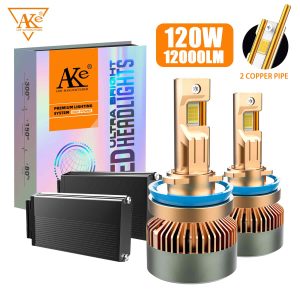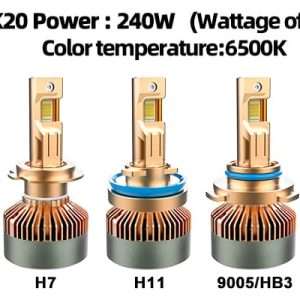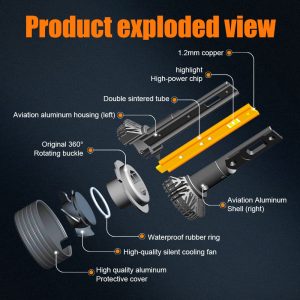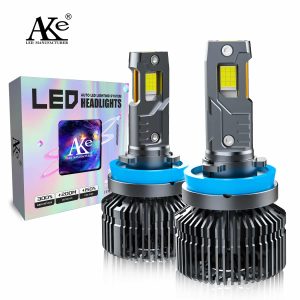For drivers, choosing the right headlights is crucial for improving vehicle safety. There are three types of headlights that are widely used in the market, namely halogen, HID, and LED headlights.
Today, I’ll give you a primer, but many people still don’t understand the differences between halogen, HID, and LED lamps. Some even mistakenly think “white light” is HID, believing it’s extremely harsh and even illegal.
Understanding the distinctions is crucial when comparing Halogen vs HID vs LED Headlights for better safety and performance on the road.
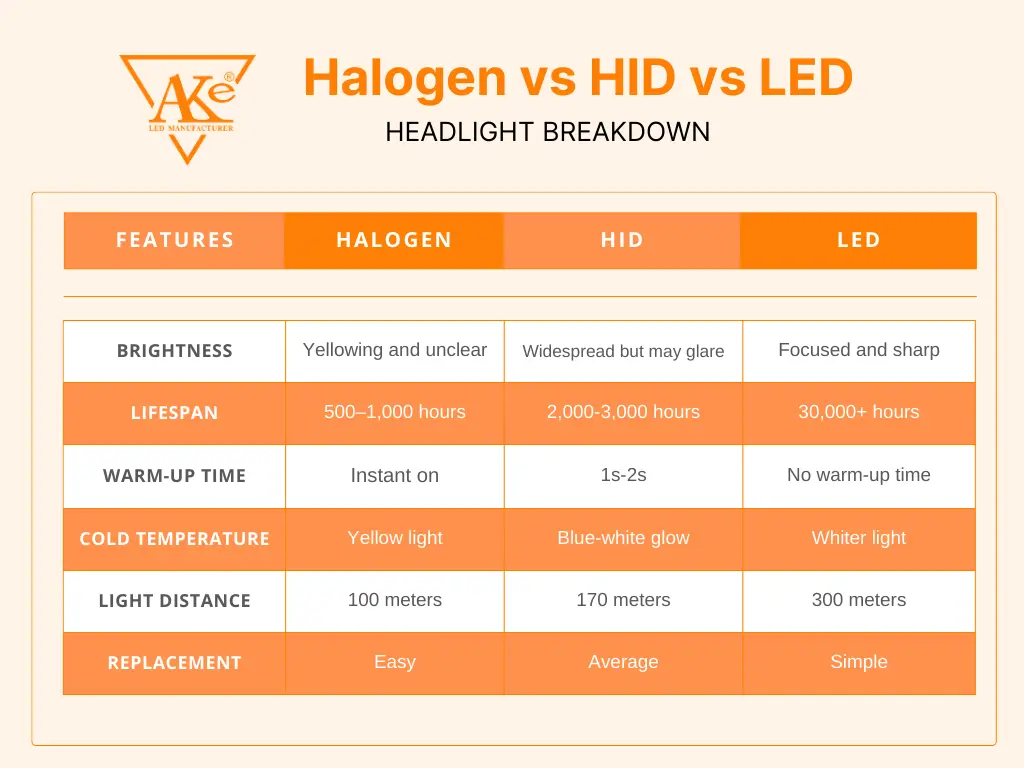
In this blog, I will comprehensively compare the main differences between halogen lamps, HID lamps, and LED headlights, analyzing them from aspects such as brightness, lifespan, price, etc., to help you make an informed choice.
What are the 3 Types of Headlights?

Halogens remain widely used due to their affordability and reliability.
HID (Xenon) is extremely bright but can cause glare.
In contrast, Faróis LED, with their energy efficiency and long lifespan, are the lighting of choice for modern vehicles.
Each of these three popular headlight types has its own unique advantages and disadvantages, affecting brightness, energy efficiency, cost, and lifespan.
What is a Halogen Headlight?

A halogen lamp is an incandescent lamp that incorporates a halogen element. It utilizes the tungsten-halogen cycle to reduce the blackening of the lamp housing effectively.
Halogen headlights are a traditional choice and are widely used in older vehicles.
How do Halogen Lights Work?
They operate by passing an electric current through a tungsten filament in a glass bulb filled with halogen gas.
What is a Halogen Headlight Used For?
Halogen headlights are the most common type of headlight on cars.
Most of the car models currently on the market that still use halogen bulbs are cheaper and more entry-level models, such as Proton Saga, Persona, Preve, Toyota Vios, Nissan Almera, etc. Basically, many high-end models are now equipped with HID or LED, which are more expensive but more efficient.
Halogen Advantages and Disadvantages
Halogen Headlight Advantages
- Inexpensive, typically costing $10-30 per bulb.
- Bright, fast illumination.
- Excellent visibility in rain and fog.
- Available at most auto parts stores and easy to install.
- Compatible with most vehicles, no modification required.
Halogen Headlight Disadvantages
- Low brightness: Brightness is approximately 1,000 to 1,500 lumens, not as bright as HID or LED headlights.
- Short lifespan: They have a lifespan of 500 to 1,000 hours and require frequent replacement.
- Low energy efficiency: They consume more electricity and put a strain on the vehicle’s electrical system.
What are HID Headlights?
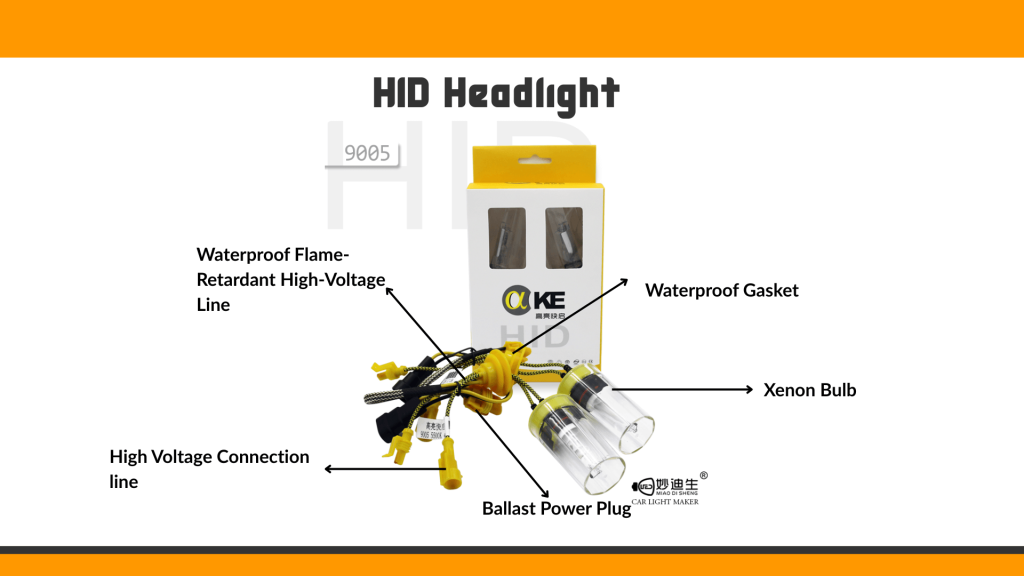
HID is also known as High Intensity Discharge.
HID headlights generate light using an arc between two electrodes within a gas-filled bulb (usually containing xenon gas), hence the name xenon headlight.
In the past few years, HID headlights have become quite popular in the aftermarket headlight market. Many owners of vehicles with halogen lamps converted their headlights to HID headlights.
How do HID Headlights Work?
HID uses the intense white light emitted by xenon gas discharge as a light source.
Because the light source is white, combined with the lens effect, it looks more attractive and provides clearer illumination at night.
What is an HID Headlight Used For?
It was not until the 1990s that HID began to be used in some high-end car brands such as BMW and Mercedes-Benz. After the 21st century, it became popular in some mass-market car brands.
HID headlights were once the mainstream choice for high-end vehicles and were also popular in the aftermarket. They are now being gradually replaced by LED headlights, which will be introduced next.
HID Headlight Advantages and Disadvantages
HID Headlight Advantages
- Brightness can reach 3,000-5,000 lumens, making them ideal for nighttime driving and inclement weather.
- They have a lifespan of 2,000-3,000 hours, outlasting halogen lamps.
- Emits bluish-white light with a color temperature of 4,000-6,000K, providing clearer and brighter lighting that simulates daylight.
- They save half the energy: Halogen lamps consume over 60W, while HID headlights only require 35W.
- If a HID headlight malfunctions, it won’t shut off instantly. Instead, it gradually dims (or re-lights quickly), giving drivers time to pull over in the dark.
HID Headlight Disadvantages
- High price; Installation is complex.
- HID headlights have a relatively long startup time, requiring three to four seconds to illuminate.
- HID headlights take several seconds to warm up before reaching full brightness.
- They also lack the penetrating power of halogen lamps in rain, snow, and fog. This is because their light is too white and lacks the penetrating power of yellow light.
- If the beam is not aligned correctly, it can cause glare to oncoming vehicles, posing a safety hazard.
What are LED Headlights?

LED stands for Light Emitting Diode.
LED headlights are headlights that use light-emitting diodes (LEDs) as their light source. Unlike traditional halogen bulbs, which rely on a filament, LEDs consist of a semiconductor diode that emits light when an electric current passes through it.
The use of LED headlights in vehicles can save energy and enable a wider variety of headlight designs.
How do LED Headlights Work?
LED headlights work by converting electrical current into light energy.
Multiple small LEDs are combined into a headlight assembly to produce bright, focused light. These LEDs illuminate almost instantly, requiring no warm-up time, and generate less heat than halogen or HID bulbs.
What is an LED Headlight Used For?
The 2008 Audi R8 was the first car to use LED headlights. Mercedes-Benz, BMW, Cadillac, Toyota, and others have also introduced cars that use LED headlights instead of halogen or HID lamps.
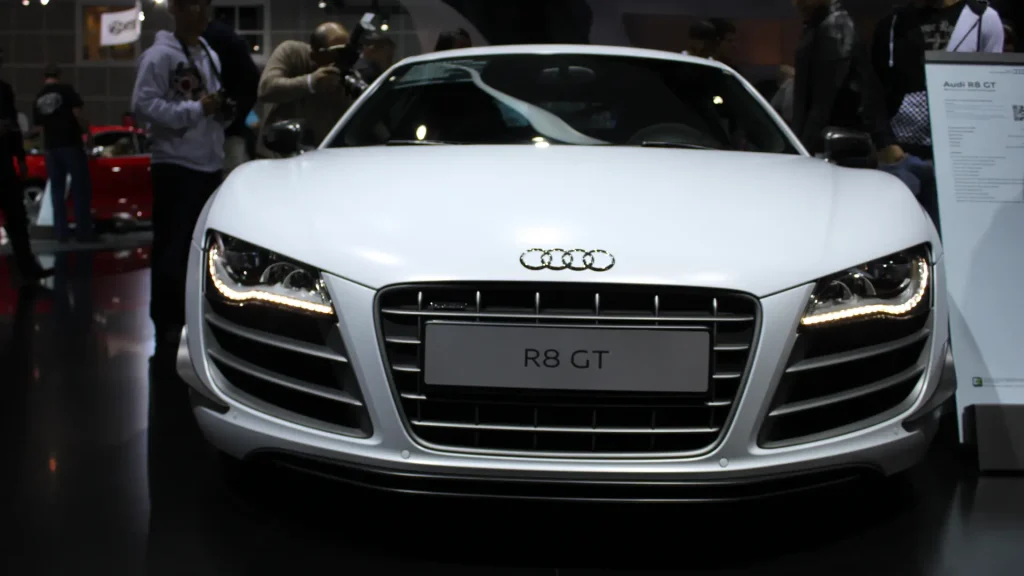
Since LED headlights became commonplace, headlight designs have become increasingly beautiful, with a wide variety of lighting options emerging.
Furthermore, LED headlights are more popular because, compared to halogen and HID lamps, they are more energy-efficient, offer higher brightness, have a shorter startup time, and can be configured in various lighting modes.
This is why they have begun replacing xenon lamps as a mainstream feature in high-end vehicles.
LED Headlights Advantages and Disadvantages
LED Headlights Advantages
- LED headlights consume only 1/20 the energy of halogen lamps, effectively reducing vehicle energy consumption.
- They typically last up to 30,000 hours, roughly the lifespan of a vehicle, and generally require no replacement.
- Excellent durability, simple lamp structure, and strong resistance to shock and vibration, with an IP68 waterproof rating.
- They light up extremely quickly, with a microsecond-level response speed, ensuring better driving safety compared to xenon and halogen headlights.
- Available in various sizes, these lamps enable automakers to design more innovative lamps.
- A low-voltage DC power supply minimizes load interference and reduces environmental requirements.
- Available in a variety of color temperatures (3,000-6,000K)
LED Headlights Disadvantages
- Poor heat dissipation can significantly shorten the lifespan.
- The initial purchase cost is high, and repairs are not very convenient.
- Older models may require adapters or modifications.
Halogen vs HID vs LED Headlights: Which Headlights are Best for You?
All things being equal — price, fit, etc, which is better for illumination of the road at night? I see so much conflicting information, and of course, the LED tech is constantly evolving. The following is a comparison of halogen, HID, and LED headlight modifications.
Comparison Of 3 Types of Car Headlights
| Feature | Halogen | HID | LED |
| Light Source | Tungsten filament + halogen | Xenon gas + electric arc | Light Emitting Diodes |
| Brightness (Lumens) | 1,000–1,500 | 3,000–5,000 | 3,000–6,000 |
| Lifespan (Hours) | 500–1,000 | 2,000–3,000 | 15,000–30,000 |
| Cost Per Bulb | $10–$30 | $50–$100 | $50–$150 |
| Energy Efficiency | Low | Moderate | High |
| Installation | Easy | Complex | Moderate |
| Warm Up Time | Instant on | 1s-2s | No warm-up time |
| Lighting Distance | 100 meters | 170 meters | 300 meters |
| Light Color | Warm yellowish | Bright white/blue | Cool white (5000-6000K) |
| Climate Adaptability | Good penetration of rain and fog | Weak light penetration | Stable light, adaptable to various weather conditions |
If we consider the overall advantages and long-term use, I personally think LED lights are more suitable, but the specific choice still depends on personal needs.
Please continue reading to fully understand the three types of headlights so that you can decide which type of headlight to choose.
Halogen vs HID vs LED Headlights: Color Temperature
Halogen Headlights: Typical color temperatures are around 3000K, producing a warm, yellowish light.
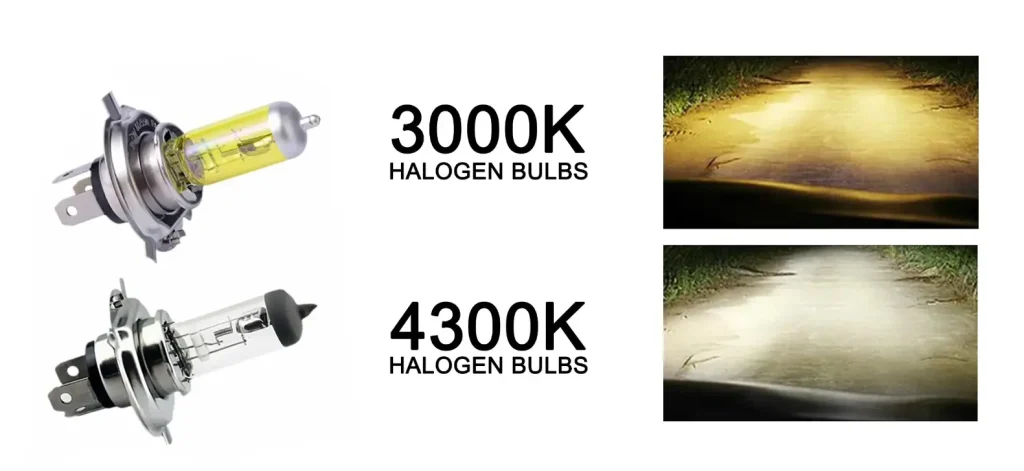
In some adverse weather conditions, such as rainy days, snowy days, and hazy days, it has strong penetration, but the brightness and clarity are lower.
HID Headlights: HID headlights offer a wide range of color temperatures, generally ranging from 3000K to 12000K.

However, professional auto modification shops generally recommend 4300K, with a few recommending 6000K. Blue-violet light above 8000K can cause glare and increase the risk of traffic accidents.
LED Headlights: LED headlights currently offer a wider range of color temperature options, including 3000K, 4300K, and 6000K, among others.
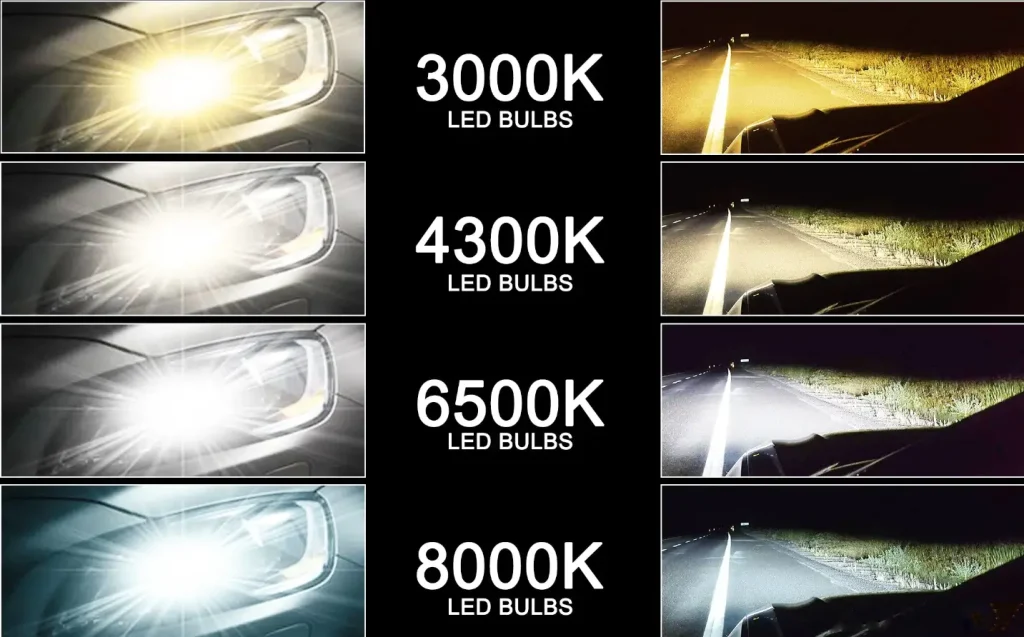
Most LED headlights have a color temperature of around 6000K, which is closer to the natural white light of the sun and is generally a preferred choice. This color temperature allows drivers to more easily distinguish road conditions and provides excellent illumination.
Halogen vs HID vs LED Headlights: Efficiency
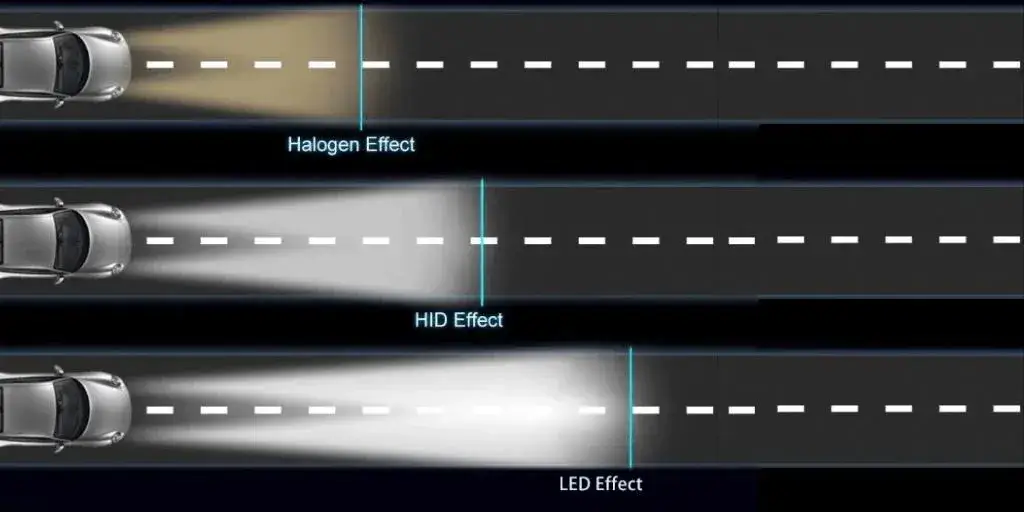
Halogen Headlights: The least energy-efficient, converting most of the electrical energy into heat, resulting in poor light efficiency.
HID Headlights: HID lamps are more efficient than traditional halogen lamps, but due to their more complex lighting system, their overall efficiency is approximately 90 lumens per watt (lm/W), lower than LEDs.
LED Headlights: LED headlights have a luminous efficiency of 80% to 90%, with top-tier products reaching 120 lumens per watt (lm/W). They convert nearly all of the electrical energy into light, with minimal heat waste.
Halogen vs HID vs LED Headlights: Lifespan
Halogen Headlights: Short lifespan, typically only 500 to 1,000 hours, requiring frequent replacement.
HID Headlights: Lifespan is approximately 2,000 to 3,000 hours. While superior to halogen lamps, their brightness gradually decreases over time.
LED Headlights: Made of durable aluminum and featuring an efficient heat dissipation design, LED bulbs are shock-resistant and corrosion-resistant, with a lifespan of up to 30,000 hours.
Halogen vs HID vs LED Headlights: Cost
Halogen Headlights: The lowest price and easy to install, but they have a short lifespan and require frequent replacement.
HID Headlights: The Initial price is lower than that of LED, but installation is more complex, with more wiring and higher maintenance costs.
LED Headlights: Manufacturing costs are higher and generally more expensive than HID lamps, but their long lifespan reduces long-term maintenance and replacement costs.
Halogen vs HID vs LED Headlights: Warm-up Time
Halogen Headlights: Light up almost instantly.
HID Headlights: Warm-up time of 1-2 seconds is required before the light reaches full brightness.
LED Headlights: No warm-up is required; the light reaches full brightness immediately upon turning on, and the response time is fast.
Why LED Headlights are Best?
- Ultra-Long Lifespan
LED headlights can last over 30,000 hours, far exceeding halogen and xenon lamps.
This means that unless an accident or serious malfunction occurs, a car equipped with properly equipped LED headlights can leave them on during daytime driving without worrying about the lamp lifespan.
- Brightness
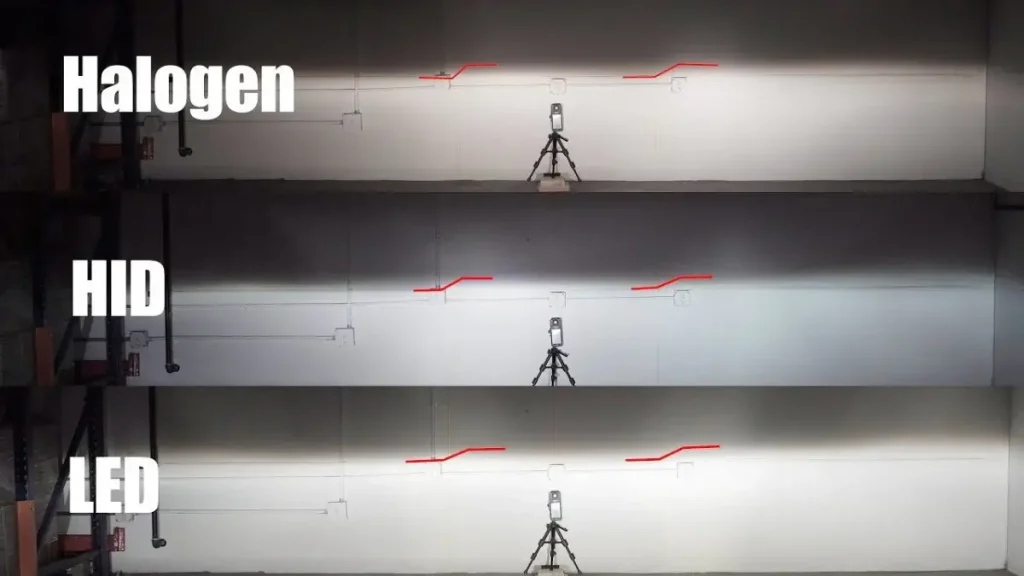
LED headlights are not only brighter than halogen and xenon lamps, but also offer superior light efficiency. This “brightness” doesn’t refer to blinding brightness, but rather to effective illumination, commonly known as “better road lighting.”
They illuminate areas where they need to be illuminated while avoiding unnecessary light leakage and glare, improving safety and comfort during nighttime driving.
- Energy Savings
LED bulbs consume less power and are more efficient, providing brighter, more focused light.
This not only reduces the vehicle’s energy burden, improves fuel economy, and reduces environmental impact, but also reaches maximum brightness instantly, requiring no warm-up time and offering extremely fast response times, enhancing driving safety.
- Wear-Resistant
LED headlights have a very simple structure, offering excellent impact and vibration resistance. There’s no need to worry about the bulbs breaking easily, making them well-suited to harsh environments.
- Small Components, Easy to Place
LED headlight components are very small, allowing for easy design and placement.
This is one of the important advantages of LED headlights, which meets the design needs of various fabricantes de faróis LED para automóveis, breaks through the traditional lighting system, creates a new lighting style, and thus achieves more perfect lighting.
- Fast Ignition
LED headlights illuminate very quickly, requiring only a subtle touch. Currently, LEDs are primarily used in headlights and taillights. Their rapid activation provides excellent warning. When used in headlights, LEDs are safer than xenon and halogen lamps.
How to Choose a Car Headlight?
I’ve seen a lot of people on Reddit asking about halogen, HID, and LED headlights, and most people are skewing one side or the other. One pertinent point is that choosing a headlight depends on the type of modification you’re planning, the configuration of your vehicle, and the features it supports.
By comparing the three types of headlights I’ve described above, you can fully understand their advantages and disadvantages.
Now you can decide which headlight type is best for your vehicle.
Before you embark on a headlight replacement, be sure to carefully weigh the pros and cons to determine whether it’s worthwhile.
Here are some tips to help you make a decision.
- Choose the type of beam you want.
- Headlights come in a variety of different designs from each LED headlight manufacturer, and when choosing new headlights for your car, make sure you choose a design that matches the design of your vehicle.
- If you’re planning to buy new LED headlights for your car, choose the color you prefer. White light is ideal.
- One of the most important considerations when replacing your car headlights is cost. You’ll find headlights in different price ranges. Choose one that falls within your budget; it’s not recommended to choose the cheapest option.
Conclusão
Whether you choose halogen, HID, or LED headlights, they all have their place in their respective automotive markets, but LED headlights are undoubtedly the future of technology.
Back to the original question: Which car headlights are best?
- Best for what? Lowest cost? Emitted light? Light diffusion?
You will find that quality varies greatly between models, brands, types, etc. Remember, any light you choose will need to be compatible with your vehicle’s wiring, or you will be looking at substantial costs to upgrade the wiring to handle the new load.
But my answer is always LED headlights. It’s not surprising that LED headlights are considered a superior choice over halogen and HID headlights, as better visibility is always key to driving safety.

